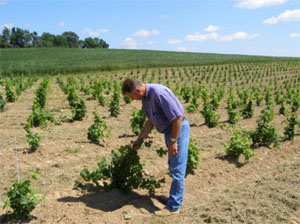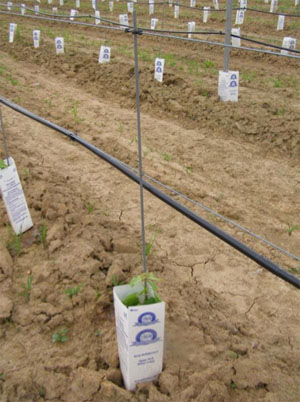Very Early Training Wire Height Cordon & Cane Development Internode Length Establishing Divided Training Systems Other Considerations More Info
Mark Chien, Pennsylvania State University
Proper training of young vines is essential to achieve desired vine structure and promote long term vineyard productivity. The method of vine training that a grower chooses will depend upon the characteristics of his or her site and production goals.
The classic method is to let the vine “bush” during the summer after it is planted to maximize leaf area and allow for root and trunk development. For a very vigorous site, some initial permanent structure training may take place. The first to third or fourth year of vineyard development is devoted to establishing the vine, a sound root system, and superstructure. The relative fertility (or capacity) of the soil, other environmental conditions, and viticultural inputs will determine the rate of growth and development of the vines. On a vigorous site, vines may yield a small crop even in the second year. On a depleted site with shallow soils, it can take five or more years to achieve full vine size and a normal crop. A proper soil evaluation will give some insight into the potential vigor of a site and what the vine training needs may be in the first year.
Very Early Training
Ideally, vines and trellis (and irrigation if necessary) are installed in the first year and proper training and maintenance can begin. The signs of a good vineyard are:
- healthy plants of uniform size,
- a stout, well-installed trellis system that includes the fruit wire, and
- a strong training stake.
Bamboo and string do not qualify as a training stake. Rolled steel or rebar are much better for vine training, especially if the stake is fastened to the fruit wire. These sturdy stakes will provide ample support for the vine during training and help protect the new vine from machinery, especially if an under-vine mechanical grape hoe is used for weed control.
Most grafted vines come with a two-bud scion from which two or more shoots will emerge. These can be loosely tied upright to a training stake or allowed to “bush” so the vine looks shrubby the first year. If the vines are vigorous, shoots will spread randomly across the vineyard floor and create problems for access by workers or tractors and will also make weed control much more difficult.
If a site is vigorous, two to three of the strongest shoots may be selected for training in the first year and loosely tied to a training stake. Shoots can be pruned according to the chosen training system in the winter. Deciding how many trunks a vine will have is a key decision and understanding the viticultural implications of one trunk or more is important. In areas with winter injury or trunk diseases, a minimum of two is recommended. It is generally a good idea to have more rather than fewer shoots than are necessary. There are many threats to shoot number and health during the establishment period such as disease, insects, wind, and deer. It’s a good idea to leave a few insurance shoots just in case.
Wire Height
Ideal fruit wire height is a critical decision. The average height for a Vertical Shoot Positioned trellis in commercial vineyards is 30 to 36 inches. This allows for ease of labor while working in the vines and picking grapes, either by hand or with a machine harvester. It also enhances air and people movement through the vineyard. However, higher density red wine vineyards are lowering the wire (as in European vineyards) to take advantage of additional warmth closer to the soil. The trade-off is additional frost and disease exposure that exists closer to the vineyard floor.
Cordon or Cane Development
Once the fruit wire height is determined, it will be necessary to decide how to train cordons or canes. If using two trunks, establish unilateral arms. If training to one trunk, top the primary shoot at the node above the wire and use the next two lower shoots to establish the canes or cordon arms. Remember that position is extremely important in vine training – as the vine matures these two nodes will tend to move upwards. You do not want the upper node to rise above the fruit wire, so make sure the upper node is 3 to 4 inches below the wire. If you are establishing multiple trunks, train each shoot/trunk as a unilateral fruit-bearing structure. If vines are growing vigorously, trim shoots at the mid-point between vines. This will cause laterals to push, which, if well-developed, can be used as spur positions when pruned in the winter. In general, however, this scenario is an indication of too much vine vigor which may make vine balance difficult to achieve. Step-wise development of a cordon is recommended for vines planted with in-row spacing of 4 feet or greater, to reduce unproductive gaps on finished cordons. During the cordon development years, a standard cordon length to retain during dormant pruning is five to six nodes, or about 18 inches per season.
Internode Length
Internode length is very important to proper vine training. If internodes are too long, training nodes will be far apart resulting in a considerable gap between where canes or cordons intersect the fruit wire. The best-trained vines have tight internodes and only a small gap on the wire. Remember, any unfilled space on the fruit wire represents lost revenue. Internode length is difficult to control. Some mild water stress will encourage shorter internodes, but this is difficult to predict or achieve in a wet climate. Grow tubes will, in most cases, encourage long internodes. They can be recommended for high production white or red, hybrid or native variety vineyard development, especially if a high-wire system is being used. Grow tubes protect young vines from herbicide and rabbit damage, but the pros and cons of their use should be evaluated. They are expensive and take time to install and remove and it is difficult to spray tubed vines adequately. They should be removed in August to allow vine tissue to harden off well before the first freeze.
Establishing Divided Training Systems
Divided training systems have their own special requirements. The vertically divided Scott Henry system requires four canes or cordons per plant on two levels separated by a 6-inch to 8-inch gap, and wires in the correct position to accept these fruiting parts. Horizontally divided systems like lyre and Geneva Double Curtain are more complicated to train and trellis. Both also require two sets of bilateral cordons that extend from arms at the head of the trunk, creating two canopies parallel to the vine row centers.
Other Considerations
Proper vine training begins with good planting technique. Hand planted vines should all be in line with the vine row. If a 4-inch or larger hole is dug, this is a lot of space for a vine to wander off center. Vine placement in the hole is important to creating a straight line.
Remove all grapes produced during the first year. While young plants do not need to be protected from fungal disease as carefully as mature vineyards, a sound disease and insect management program must be in place. Weed management is vital to the successful growth and development of new vines. Excessive competition can do temporary or permanent harm to the long-term health of a grapevine.
Summary
New vine training is one of the most important steps in vineyard development. Because grapevines are perennial plants, you will have to live and work with the results of your training efforts for many years. It is best to do it correctly for the sanity of the grower, health of the grapevine and long term sustainability and profitability of the vineyard.
Recommended Resources
Reviewed by Fritz Westover, Texas AgriLife Extension
and Jim Wolpert, UC Davis



